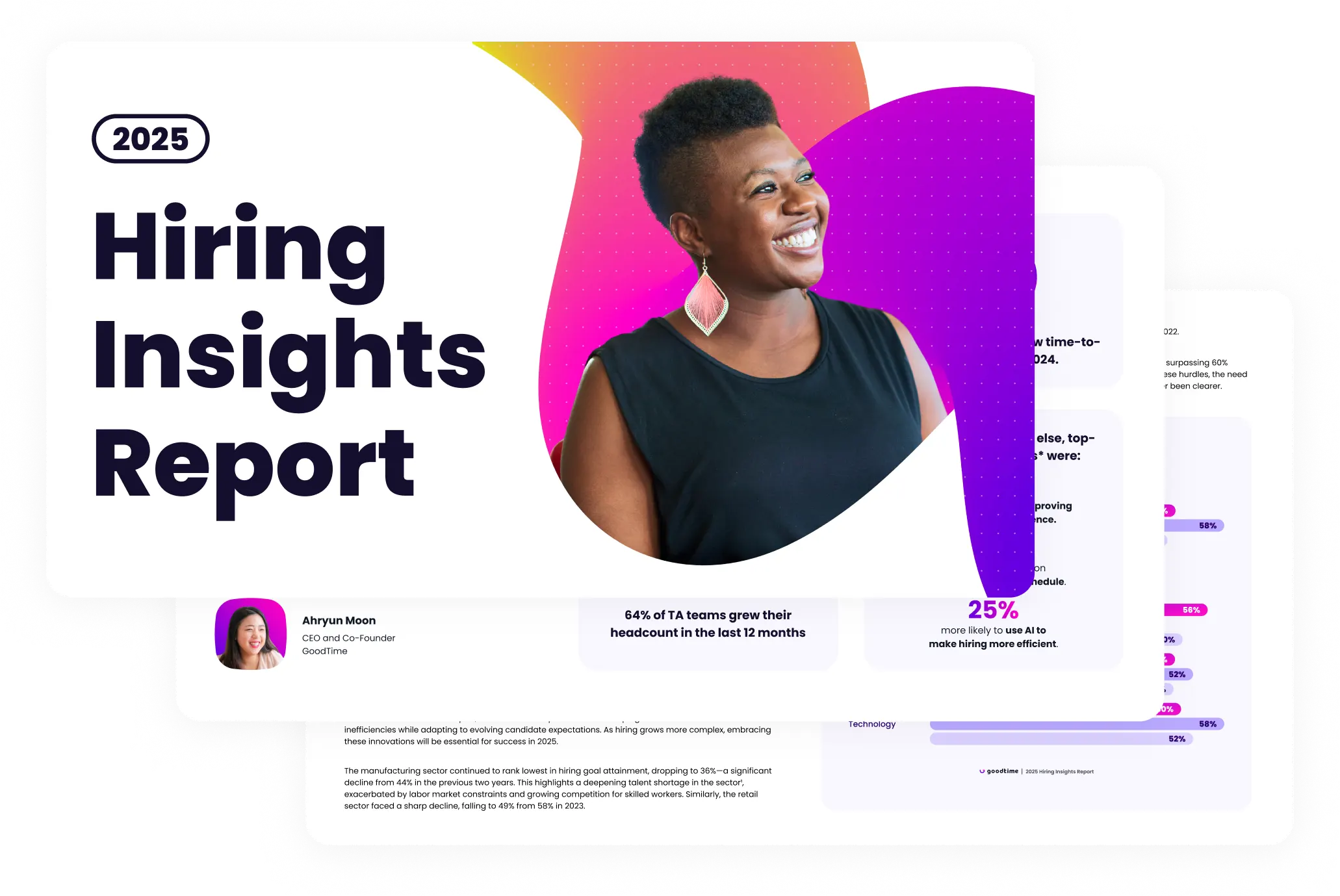Table of Contents
For global enterprises, hiring has always been a high-stakes balancing act. The scale and complexity of operations demand efficiency and precision, yet the best talent decisions are made through empathy, relationships, and human insight. Talent acquisition leaders are constantly being asked to do more with less — to move faster, with smaller teams, and to deliver exceptional candidate experiences across dozens of time zones and functions.
Now, a new force is reshaping what’s possible. Intelligent AI agents — not static chatbots or basic automation, but software that can think, act, and orchestrate work — are quietly transforming the foundation of enterprise recruiting.
As Hung Lee, founder of Recruiting Brainfood and moderator of a recent fireside chat with S&P Global, put it, “2025 may be the year we look back on as when AI agents truly arrived in our day-to-day work.”
That prediction is already proving true at S&P Global, where a sweeping transformation led by Tiffany Clark, Global Head of People Solutions & Wellbeing, has redefined what enterprise hiring looks like at scale. Facing a post-merger hiring surge and 41-step interview scheduling processes, her team embraced AI-powered orchestration to remove 80% of manual work — and, in the process, unlocked a more human experience for candidates, hiring managers, and recruiters alike.
What makes this story worth studying isn’t just the technology. It’s how S&P Global approached transformation: methodically, people-first, and focused on redefining how humans and AI can collaborate. This is the new frontier of talent acquisition — where enterprise consistency meets empathy, and AI acts as the digital workforce behind every great hire.

Unlock 2025’s top hiring strategies: Insights from 500+ TA leaders
Be the first to uncover deep hiring insights specific to your sector — straight from the highest-performing TA teams.

The catalyst for change: Mergers, scale, and opportunity
For S&P Global, the push toward transformation wasn’t born from curiosity about new technology — it came from necessity. When S&P Global merged with IHS Markit in 2022, the combined organization suddenly spanned six global regions, with thousands of hires flowing through an already complex talent ecosystem. Processes were duplicated, tech stacks were fragmented, and hiring coordination had become an operational bottleneck.
As Tiffany Clark recalls, the merger was both a challenge and an opportunity.
“When we merged with IHS in 2022, our volume skyrocketed — more processes, more workflows. We needed to unlock productivity for our people team, not just add more steps.”
The new scale exposed what many enterprise TA leaders already know: complexity compounds fast. Even with the best recruiters and systems, manual coordination across continents can slow everything down — eroding candidate experience and putting hiring teams under pressure to deliver results faster than ever.
Rather than layering on another tool or hiring wave after wave of coordinators, Clark and her team made a bold decision: to reimagine their hiring operations from the inside out. That meant moving beyond traditional automation — which only pushes buttons faster — and embracing an approach that could think, act, and orchestrate across their entire ecosystem.
It was the start of a journey toward what Clark describes as “human-centered automation” — powered not by macros and workflows, but by intelligent AI agents capable of understanding context, making decisions, and freeing people to focus on the work that truly matters.
From automation to orchestration: What agentic AI really means
Across enterprise HR, automation has long promised relief from manual busywork — yet for many teams, it only accelerated the motions of outdated processes. Email templates, workflow triggers, and reminders can make hiring faster, but not necessarily smarter. That’s the distinction Tiffany Clark draws when describing what separates “traditional automation” from the new era of agentic AI.
“Traditional automation is linear — it moves steps along the process. Agentic AI orchestrates all those activities, making decisions and acting across systems in real time.”
At S&P Global, this distinction was more than technical — it was cultural. Instead of treating AI as a background efficiency tool, Clark’s team saw it as a partner in transformation. The AI agents deployed through GoodTime didn’t just automate reminders or schedule requests; they learned, reasoned, and acted. They could analyze calendars, coordinate time zones, update systems, and optimize interview sequences — all while keeping recruiters and hiring managers informed.
“It’s how the agents unlock productivity,” Clark explained. “They handle orchestration, not just execution — leveraging data and insights to make more informed decisions.”
For Charles Mah, GoodTime’s Chief Operating Officer, that’s precisely where the shift becomes profound.
“Automation is great at linear transactions,” he noted. “But agentic AI acts like a partner — it thinks through the edge cases, adapts dynamically, and drives better results.”
That dynamic intelligence is what turns technology from a task executor into a digital teammate. It’s not about removing people from the process — it’s about letting humans focus on moments that matter, while AI keeps the machinery of hiring in sync.
In essence, agentic AI doesn’t just assist recruiters; it augments them. It replaces friction with flow — and transforms enterprise hiring from a series of handoffs into a coordinated act of orchestration.
The first win: Tackling interview scheduling chaos
Every major transformation starts with a single, solvable pain point. For S&P Global, that was interview scheduling — an everyday task that had quietly become a massive drain on time, energy, and morale.
Before introducing AI agents, scheduling a single interview required an astonishing 41 steps. Recruiters, coordinators, hiring managers, and candidates were locked in endless loops of emails, calendar conflicts, and time zone mismatches. Each interview could take half an hour to coordinate — multiplied by hundreds of hires a month across regions, the inefficiency was staggering.
Tiffany Clark and her team saw an opportunity to test AI orchestration where it mattered most.
“It took 41 steps to schedule one interview,” she recalled. “With AI agents handling orchestration, we cut that to eight — and scheduling time dropped from 30 minutes to five.”
The use case was strategic: scheduling was high-volume but low-risk, a perfect sandbox for deploying AI without disrupting sensitive HR decisions. The result was immediate. GoodTime’s AI agents — part of its Orchestra platform — took on the complex coordination work, reading calendars, booking rooms, and updating interviewers automatically.
Clark emphasized that success depended on careful deployment and partnership.
“Particularly when we rolled out GoodTime, we did it in phases,” she explained. “We started first in the Americas, where we knew we had high enough volume but less regional complexity. Then we rolled out to APAC and EMEA, and finally to India.”
That phased approach, she noted, allowed the team to refine workflows and adapt the solution to regional nuances without disrupting hiring continuity.
The impact rippled outward:
- 90% reduction in scheduling time
- 2,400+ hours of annual productivity returned to S&P’s Candidate Care team
- A measurable boost in recruiter satisfaction and candidate experience
Just as importantly, it proved a broader hypothesis: when AI agents orchestrate the operational layer, human teams can refocus on strategic, high-value work.
What began as a pilot in scheduling soon became a blueprint for rethinking the entire hiring lifecycle — from first contact to final offer — through the lens of orchestration rather than automation.
What changes when AI takes on the busywork?
Once the scheduling burden shifted from humans to AI agents, the real transformation began. For Tiffany Clark and her team, automation wasn’t the end goal — it was the beginning of a mindset shift about what talent acquisition work could look like when people weren’t buried in logistics.
“Our coordinators can now focus on the interactions that matter,” Clark said. “Guiding candidates, coaching hiring managers, and refining the experience instead of chasing calendars.”
That shift in focus became a powerful cultural signal. The team wasn’t just getting time back — they were getting purpose back. Conversations that used to center on bottlenecks began to focus on candidate experience, hiring manager enablement, and strategic workforce alignment.
As GoodTime’s CEO Ahryun Moon reflected during the conversation, this is where AI’s true potential shows up — not in what it automates, but in what it enables.
“AI won’t be able to replace the human touch,” Moon said. “It gives us time to be more human again — to excite candidates, understand their needs, and create experiences that feel personal and connected.”
That theme — the return to “being good at being human” — resonated throughout the discussion. Efficiency gains can easily become a numbers game, but Clark’s team made a deliberate choice to reinvest their time into empathy and connection.
GoodTime COO Charles Mah took it a step further, noting that the shift to higher-value work also demands new leadership behaviors.
“We’ve spent years incentivizing recruiters on speed and volume,” he said. “Now we need to reward the relationship work — the quality of the experience, even for candidates who aren’t hired.”
It’s a point that reframes the ROI of AI. When technology handles the repeatable, humans can elevate the irreplaceable — the conversations, coaching, and empathy that define world-class talent acquisition.
At S&P Global, that’s become the true measure of progress: not just faster hiring, but more human hiring at scale.
Leading through transformation: Change management at scale
Scaling innovation across a global enterprise is rarely just a technical challenge — it’s a human one. For Tiffany Clark, the success of S&P Global’s AI transformation hinged on how well her team could navigate both.
“We always start with the standard process,” she explained. “Then we work our way back from the nuances — asking why something is different, and whether there’s a true business or regulatory reason for it.”
This approach — global first, local second — helped S&P Global strike the right balance between consistency and adaptability. Too often, Clark noted, regional teams defend their way of working out of habit rather than necessity.
“People have a tendency to lead with exceptions,” she said. “But when you start asking why, you often find that what feels unique is actually aligned with the global process.”
That disciplined curiosity became a guiding principle for rolling out GoodTime across the organization. Rather than launching everywhere at once, Clark’s team phased implementation region by region — beginning in the Americas, then expanding to APAC, EMEA, and finally India.
“We started where we had high enough volume but fewer complexities,” she said. “Each rollout taught us something we could apply to the next one.”
The team’s phased rollout wasn’t just about geography; it also reflected product maturity.
“We went with GoodTime Meet first, and then we launched GoodTime Hire,” Clark shared. “That gave us the flexibility to refine workflows and support change management along the way.”
Equally critical was what happened after launch. Clark’s team implemented what she called a “hypercare period” — a structured window of extra support immediately following each regional deployment.
“That hypercare period allowed teams to identify challenges early,” she said. “It gave them the confidence to iterate quickly and feel supported while adopting something new.”
The impact of this approach went beyond process improvement. It built trust. By inviting local teams to contribute feedback and see their input reflected in subsequent rollouts, Clark’s group turned change management into change ownership.
And when resistance inevitably surfaced? Clark relied on what she called a “show and tell” philosophy.
“You have to be comfortable trying something,” she said. “If it doesn’t work, pull it back and pivot. That flexibility builds trust.”
It’s a leadership playbook that feels tailor-made for the AI era — pragmatic, transparent, and rooted in collaboration. At S&P Global, it’s also what transformed a global rollout into a lasting cultural shift.
Building trust in AI: Transparency and partnership
For all its promise, AI adoption in HR often stumbles on a single word: trust. Not trust in the math or the mechanics — but trust in how technology interacts with people’s work, judgment, and accountability. Tiffany Clark approached that challenge head-on.
“When you talk about AI, it’s the trust element that really drives adoption,” she said. “You have to be comfortable trying something new. If it doesn’t work, pull it back — then try again.”
That pragmatic openness defined S&P Global’s rollout. Clark’s team positioned AI agents not as a replacement for human decision-making, but as a partner — one that could handle orchestration and complexity while keeping people firmly in control. It was a principle reflected in every phase of deployment: start small, show results, and invite feedback.
“I like to use the term ‘show and tell,’” Clark said. “Let’s try it. If it works, great. If not, we adjust. That’s how you build credibility and confidence.”
Her emphasis on transparency extended to vendor collaboration as well. S&P Global’s partnership with GoodTime and its Orchestra AI agents was treated not as a handoff to technology, but as an ongoing dialogue between systems, teams, and outcomes.
“We really looked at three things,” Clark explained. “How does this integrate with our existing tech stack? How agile is it to grow and mature with us? And does it align with our organization’s priorities?”
That intentional vetting — grounded in business strategy, not hype — helped ensure that AI fit into S&P Global’s ecosystem rather than sitting on top of it. Clark also emphasized the importance of working hand-in-hand with internal technology partners.
“We needed strong partnership with our digital solutions and IT teams,” she said. “Understanding where they’re headed helps ensure what we adopt supports that journey too.”
By treating AI adoption as a shared enterprise effort, not an HR side project, Clark’s team helped normalize technology as a trusted collaborator. The result: smoother adoption, stronger partnerships, and an AI system that felt like an extension of the team — not an intrusion.
“Trust comes from transparency and iteration,” Clark said. “You bring people with you — not just onto the platform, but into the process.”
Reinvesting saved time into better hiring experiences
Efficiency is only half the story. The more profound outcome of S&P Global’s AI transformation wasn’t just speed — it was what the team did with the time they got back.
By automating 80% of manual scheduling and coordination, Tiffany Clark’s team reclaimed thousands of hours once spent on repetitive, transactional work. That reclaimed capacity didn’t go toward doing more of the same — it went toward doing better, more human work.
“Our coordinators can now focus on the interactions that matter,” Clark said. “They’re spending more time guiding candidates, coaching hiring managers, and improving the experience instead of chasing calendars.”
That reframing of productivity — from task completion to relationship quality — reflects a growing movement across enterprise HR. When the operational noise fades, teams can finally hear the signals that drive lasting impact: empathy, connection, and experience.
GoodTime CEO Ahryun Moon captured this shift perfectly.
“AI won’t replace the human touch,” she said. “It gives us time to be more human again — to excite candidates, understand their needs, and create experiences that feel personal and connected.”
This re-centering of humanity in hiring is more than a philosophical point — it’s an operational advantage. As AI handles the repetitive, recruiters can act as true advisors, managers can engage more deeply, and candidates feel valued from the first touchpoint to the offer stage.
GoodTime COO Charles Mah added that this change must be reflected in how talent teams are measured and rewarded.
“We’ve spent years incentivizing recruiters on speed and volume,” he said. “Now we need to reward the relationship work — the quality of the experience, even for candidates who aren’t hired.”
That simple shift — from efficiency metrics to experience metrics — could redefine what success in TA looks like.
At S&P Global, it already has. Time saved has become time invested — back into people, experiences, and the moments that shape lasting impressions of the brand. For Clark, that’s the real promise of AI: not just faster hiring, but more meaningful human connection at scale.
The enterprise playbook: Lessons for TA leaders
For enterprise talent leaders, the story of S&P Global’s transformation isn’t just about technology — it’s a roadmap for what it takes to make large-scale change real. Tiffany Clark’s experience offers a set of lessons that extend well beyond AI or scheduling software. They’re about leadership, experimentation, and staying human in the face of complexity.
1. Anchor on a clear use case
Big transformations begin with small, solvable problems. For S&P Global, that was scheduling — a universal pain point that touched every recruiter and region.
“Start with something tangible that everyone can rally around,” Clark advised during the session. “Once you show results, momentum builds on its own.”
2. Standardize globally, flex locally
Clark’s mantra — “start with the standard, then work back from the nuance” — became a cornerstone of the rollout. It helped the team maintain global consistency while allowing local teams to adapt where it truly mattered.
“People lead with exceptions,” she said. “But when you start asking why, you often find what feels unique isn’t so different after all.”
3. Build trust through iteration
AI adoption isn’t a one-and-done implementation — it’s a relationship. Clark’s “show and tell” approach emphasized experimentation, learning, and visible course correction as a way to build confidence.
“You have to be comfortable trying something,” she said. “If it doesn’t work, pull it back and pivot. That flexibility builds trust.”
4. Treat AI as a teammate, not a tool
S&P Global’s success hinged on seeing GoodTime’s AI agents as partners, not utilities. They orchestrated work while keeping humans in control — an approach that encouraged ownership, not resistance.
“We really looked at how the technology would grow and mature with us,” Clark noted. “It wasn’t about replacing work; it was about elevating it.”
5. Redefine success metrics
Speed and volume still matter, but they’re no longer the full story. As Charles Mah noted, the next wave of TA excellence will measure the quality of relationships — even with candidates who don’t receive offers.
“Efficiency opens the door,” he said. “Experience builds the brand.”
Together, these lessons form a new playbook for modern TA leaders: start small, stay transparent, move fast, and always center people — both in your teams and in your candidate journeys.
At S&P Global, that philosophy didn’t just make hiring faster; it made it better. It’s a reminder that the best technology transformations are, at their core, human transformations.
The future of hiring orchestration
For years, enterprise recruiting has been caught between two forces: the relentless need for speed and the human desire for connection. S&P Global’s transformation shows that these aren’t opposing goals — they’re complementary when orchestrated through intelligent AI.
What Tiffany Clark and her team achieved wasn’t just a process upgrade. It was a redefinition of how work gets done — where people lead, and AI acts as the digital workforce operating in sync behind them. The results were clear: faster hiring, fewer bottlenecks, and a renewed focus on human experience at every stage.
“The goal isn’t just speed,” Clark said. “It’s to free people to focus on what matters most.”
That simple statement captures the promise of AI-powered orchestration. When technology becomes capable of action — not just reaction — it allows organizations to operate with the agility of a startup and the humanity of a trusted employer brand.
Moderator Hung Lee closed the conversation with a prediction that felt less like speculation and more like a statement of fact:
“This is the moment when AI agents stop being a concept and start becoming part of how teams work.”
If that’s true, S&P Global’s journey offers a glimpse of what’s next for every enterprise TA leader: a world where digital and human workforces operate side by side, where transformation is continuous, and where hiring finally feels as connected as the people it brings together.




